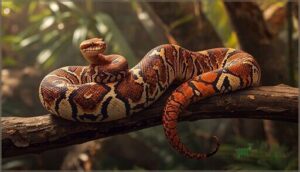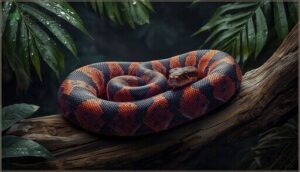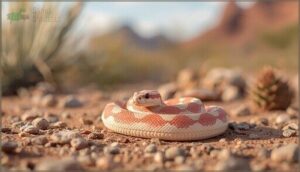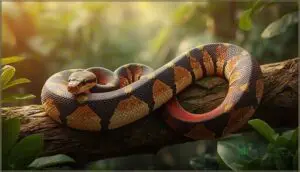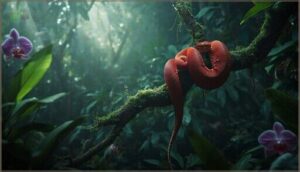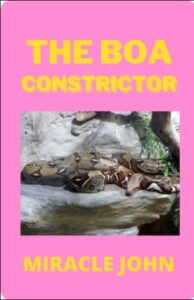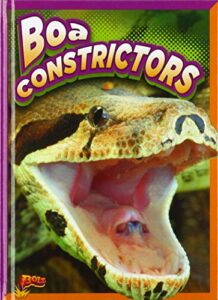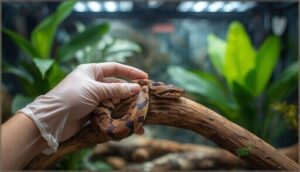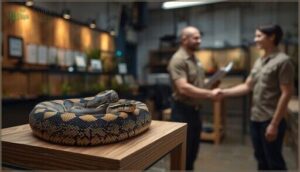This site is supported by our readers. We may earn a commission, at no cost to you, if you purchase through links.
You can’t just walk into a pet store and pick up a boa constrictor like you would a goldfish, and that’s probably for the best. These impressive constrictors demand respect, proper care knowledge, and a commitment that spans decades. However, when you find the right snake from a trusted breeder, you’re gaining a fascinating companion that’ll turn heads and spark conversations for years to come.
The market for boa constrictors has exploded recently, with breeders producing stunning morphs and localities that weren’t available even five years ago. This means you’ve got more choices than ever before. Exploring reputable sellers, understanding health indicators, and matching the right species to your experience level will transform your search from overwhelming to enabling.
Table Of Contents
- Key Takeaways
- Best Boa Constrictors for Sale Online
- Top 6 Boa Constrictor Products Reviewed
- How to Choose a Healthy Boa Constrictor
- Where to Buy Boa Constrictors Safely
- Essential Boa Constrictor Care Tips
- Frequently Asked Questions (FAQs)
- Where can I buy boa constrictors?
- What is a boa constrictor snake?
- How much does a Baby Boa Constrictor cost?
- What is a red tail boa constrictor?
- Which is more aggressive, Python or boa?
- What is the lifespan of a boa snake?
- Are boas good pet snakes?
- What is the best beginner boa constrictor?
- How can I identify a captive-bred boa?
- What are common signs of stress in boas?
- Conclusion
Key Takeaways
- Choosing a healthy boa constrictor requires inspecting clear eyes, smooth skin, active behavior, and verifying legal documentation from reputable breeders who provide health certificates and live arrival guarantees.
- Popular beginner-friendly species include Colombian Red Tail boas for their calm temperament and manageable 6-8 foot size, while Rosy boas offer compact care at just 2-3 feet for those wanting smaller specimens.
- Proper boa care demands precise environmental control with 80-90°F basking zones, 60-70% humidity, appropriately sized frozen-thawed prey every 5-14 days depending on age, and secure enclosures measuring at least 4-6 feet for adults.
- Pricing varies significantly based on morph rarity and breeder reputation, ranging from $100-$300 for Rosy boas up to $250-$800 for rare Amazon Tree boas, with additional costs for shipping, accessories, and ongoing care over their 20-30 year lifespan.
Best Boa Constrictors for Sale Online
When you’re ready to bring home your first boa constrictor, choosing the right species makes all the difference in your journey as a keeper. We’ve narrowed down the top five boas that combine stunning appearance with manageable care requirements, giving you the confidence to start strong.
Let’s explore the best boa constrictors you can purchase online and discover which one fits your vision perfectly.
Colombian Red Tail Boa Constrictors
Colombian Red Tail Boa Constrictors are powerful, striking snakes you’ll find irresistible if you’re ready to master Reptile Breeding and Snake Care! These boas usually reach 6 to 8 feet in captivity, displaying rich rusty tails and calm temperaments that make handling rewarding.
When you understand Red Tail Genetics and provide proper Habitat Design with temperatures around 88–92°F, adequate Boa Nutrition through appropriately sized prey, and attention to Snake Behavior during shedding, you’re embracing the art of keeping these splendid constrictors thriving.
To further deepen your understanding of scientific study summaries, consider exploring methodological rigor in research related to animal care.
Brazilian Rainbow Boa Constrictors
If you crave iridescent beauty in your Reptile Breeding collection, Brazilian Rainbow Boa Constrictors are the pivotal next step in mastering Snake Care! These Boas glow like living jewels under light, usually reaching 5 to 7 feet, and captive-bred Color Morphs let you explore genetics while respecting Reptile Laws.
With proper Habitat Creation, balanced Snake Nutrition, and awareness of Boa Behavior during nighttime activity, you’ll command their mystique effortlessly!
Rosy Boa (Lichanura Trivirgata)
For those commanding Desert Ecosystems in compact form, the Rosy Boa (Lichanura trivirgata) transforms Boa Handling into an art of precision! Generally 2 to 3 feet long, these Captive Bred gems thrive under simplified Habitat Creation and straightforward Reptile Nutrition, making them perfect for Reptile Breeding enthusiasts mastering Snake Behavior without the sprawl of larger Boa Constrictors.
Guyana Red Tail Boa Constrictors
If you’re mastering Red Tail Genetics with bold ambition, Guyana Red Tails deliver striking coloration and impressive 6-to-8-foot stature, perfect for Snake Breeding projects focused on distinctive Boa Morphs!
Their fading body bands and rich red tails make them standout specimens in Boa constrictor sales, while proper Habitat Creation with tropical humidity meets their Snake Behavior and Boa Nutrition needs beautifully.
Amazon Tree Boas
These stunning arboreal specialists bring South American Distribution mystery and elegance to Boa constrictor sales, thriving in vertical Habitat Research setups that mirror their rainforest origins!
Amazon Tree Boas demand specialized Tree Boa Care with precise humidity and climbing branches, rewarding dedicated keepers through Snake Behavior observation and Snake Care and Husbandry mastery:
- Distinctive slender build and prehensile tail
- Striking color variations from yellow to deep red
- Nocturnal hunting instincts and arboreal lifestyle
- Specific dietary needs requiring appropriately-sized prey
- Temperamental handling requiring patient socialization
Top 6 Boa Constrictor Products Reviewed
Whether you’re bringing home your first boa or expanding your collection, the right resources can transform your experience from overwhelming to invigorating.
We’ve reviewed six essential products that cover everything from live snake purchases to educational guides that’ll deepen your understanding of these impressive constrictors.
Let’s explore the top options that’ll help you master boa ownership with confidence.
1. Boa Constrictor Pet Snake Sale
Looking to secure your first boa constrictor and discover the secrets of responsible reptile breeding and sales? You’ll find diverse boas for sale from experienced breeders who prioritize pet safety and proper snake care and husbandry.
When you’re choosing your pet reptile, verify the seller provides legal documentation confirming captive-bred status, plus live arrival guarantees that protect your investment. Focus on boa care essentials like health certificates and detailed breeding tips, and always check local reptile laws before completing your purchase to ascertain you’re building your collection the right way.
| Best For | First-time boa owners seeking captive-bred snakes from licensed breeders who provide legal documentation, health guarantees, and post-sale care guidance. |
|---|---|
| Primary Focus | Live boa sales |
| Target Audience | First-time boa owners |
| Price Range | Varies significantly |
| Information Depth | Care guides included |
| Educational Value | Breeding and care info |
| Practical Application | Live pet acquisition |
| Additional Features |
|
- Reputable sellers include health certificates, live arrival guarantees, and detailed care guides to support new reptile owners through the transition period.
- Wide selection of morphs and color patterns available with transparent genetics documentation, allowing buyers to choose based on appearance and temperament.
- Legal compliance and ethical sourcing reduce risks associated with unverified sellers, ensuring your pet comes from responsible captive breeding programs.
- Prices vary significantly based on morph rarity and lineage, with shipping costs and additional accessories potentially increasing the total investment.
- Regional regulations and permit requirements can complicate purchases, requiring buyers to verify local wildlife laws before completing transactions.
- Limited ability to assess temperament and health in person when buying online, making seller reputation and return policies critical to a successful purchase.
2. Big Boa Constrictor Snakes Book
Transform your boa constrictor knowledge with this compact yet powerful reference guide that delivers essential reptile husbandry insights for large-bodied boas. You’ll uncover specialized boa care techniques, detailed snake breeding protocols, and thorough morphs documentation that elevates your reptile breeding and sales expertise.
While publication details vary across editions and pricing fluctuates in specialty markets, this book reviews critical enclosure requirements, diet strategies, and health considerations customized specifically for giant boas for sale, making it an invaluable tool for serious keepers pursuing mastery in reptile care.
| Best For | Hobbyists, breeders, and experienced reptile keepers who want a focused reference on care, housing, and husbandry for large boa constrictor species. |
|---|---|
| Primary Focus | Care reference guide |
| Target Audience | Experienced keepers/breeders |
| Price Range | Specialty market pricing |
| Information Depth | Specialized care techniques |
| Educational Value | Husbandry and morphs |
| Practical Application | Reference for giant boas |
| Additional Features |
|
- Covers specialized care needs for giant boas including enclosure setup, diet plans, and health considerations that aren’t always found in general reptile guides.
- Includes practical details on morphs, breeding, and species identification useful for both new and seasoned boa keepers.
- Compact format makes it easy to reference quickly when you need specific information about large-bodied boa care.
- Publication details and content quality vary widely between editions, making it hard to know what you’re getting before purchase.
- Availability is limited mainly to specialty reptile shops and niche online sellers, so it can be tough to track down.
- Pricing is inconsistent across the resale market, and some editions may not justify the cost for a relatively short guide.
3. HyDren Giant Boa Constrictor Plush
Your mastery over reptile breeding and sales extends beyond living specimens, and the HyDren Giant Boa Constrictor Plush at $23.99 bridges your passion for boas for sale with creative reptile decor.
This giant stuffed snake replica measures 200 cm, features soft plushies material and a flexible vertebrae design that draws eyes in any reptile enthusiast community space.
With proper plush toy care like gentle surface cleaning, you’ll preserve its realistic scale patterns. It’s perfect for jungle-themed displays or as a unique conversation starter that showcases your dedication to snake care and maintenance.
| Best For | Reptile enthusiasts, collectors, and anyone looking for a realistic giant snake decoration that doubles as a soft plush toy or conversation piece. |
|---|---|
| Primary Focus | Plush toy replica |
| Target Audience | Reptile enthusiasts/collectors |
| Price Range | $23.99 |
| Information Depth | Basic replica details |
| Educational Value | Visual decoration only |
| Practical Application | Decor and conversation piece |
| Additional Features |
|
- Impressive 200 cm length with flexible vertebrae design creates a realistic look perfect for jungle themes or reptile displays
- Soft polyester material makes it versatile as a toy, pillow, cushion, or decorative piece for any space
- Affordable at $23.99 with multiple color options to match your style or collection
- Stuffing may shift and pool over time, requiring occasional fluffing to maintain the snake’s shape
- Not suitable for machine washing—requires gentle surface cleaning only to preserve the fabric
- May not appeal to those with snake phobias, even though it’s designed to be soft and cuddly
4. Boa Constrictors As Pets Guide
You won’t attain true mastery over exotic pet ownership without a thorough resource, and the Boa Constrictors As Pets Guide at $45.73 delivers critical pet care tips across 32 pages.
This trusted resource covers reptile laws, boa behavior, and snake nutrition, while addressing exotic pet ethics through habitat setup, health monitoring with veterinary checkups, and understanding boa constrictor morphs.
For anyone serious about pet reptile success, this guide transforms complex reptile care and maintenance into actionable snake care strategies that protect both your investment and your boa’s wellbeing.
| Best For | New and experienced boa owners who want a comprehensive guide covering legal requirements, health monitoring, habitat setup, and ethical considerations for keeping these reptiles as pets. |
|---|---|
| Primary Focus | Ownership guide book |
| Target Audience | New and experienced owners |
| Price Range | $45.73 |
| Information Depth | Comprehensive 32 pages |
| Educational Value | Legal and health guidance |
| Practical Application | Ownership compliance guide |
| Additional Features |
|
- Covers essential compliance topics like local wildlife laws, import permits, and legal documentation needed for ownership
- Provides detailed health guidance including signs of wellness, common diseases, veterinary checkup schedules, and proper shedding cycles
- Explains boa morphs and genetics with breeding considerations, helping owners understand color variations and maintain genetic diversity
- High price point at $45.73 may be prohibitive for casual readers or those just exploring the idea of boa ownership
- Limited to 32 pages, which might not provide enough depth for complex medical issues or advanced breeding programs
- Physical format (8 ounces, specific dimensions) may be less convenient than digital alternatives for quick reference during care routines
5. Boa Constrictors Kids Learning Book
Building tomorrow’s reptile enthusiasts starts with quality learning resources, and this Boa Constrictors Kids Learning Book at 24 pages brings essential reptile education through snake biology and boa facts perfectly suited for curious young minds.
Published by Bellwether Media, you’ll find thorough reptile care and maintenance concepts paired with habitat details and hunting behaviors that transform basic kids literature into powerful reptile breeding and genetics foundations.
For pet reptile families and reptile enthusiasts raising the future generation, this resource plants seeds of knowledge that grow into a lifelong passion.
| Best For | Parents and educators looking for an introductory reptile book to spark interest in wildlife and snake biology for children in grades 1-3. |
|---|---|
| Primary Focus | Children’s educational book |
| Target Audience | Children grades 1-3 |
| Price Range | Standard book pricing |
| Information Depth | Introductory 24 pages |
| Educational Value | Basic snake biology |
| Practical Application | Elementary education tool |
| Additional Features |
|
- Covers essential topics like appearance, habitat, and hunting habits in an accessible 24-page format that won’t overwhelm young readers
- Published by Bellwether Media with clear language and engaging visuals that make complex snake biology understandable for early elementary students
- Compact size (6.7 x 0.3 x 9 inches) and lightweight design make it easy for small hands to hold and carry to school or during travel
- Published in 2010, so some information about boa constrictors and their conservation status may be outdated
- Only 24 pages means the content stays surface-level and may leave curious kids wanting more detailed information
- Focuses specifically on boa constrictors, so children interested in learning about multiple snake species will need additional books
6. Boas And Pythons Worldwide Guide
When young learners outgrow picture books, you’re ready for Mark O’Shea’s Boas And Pythons Worldwide Guide, which brings over 100 species across five continents into sharp focus with stunning photography and field research.
This reference bridges reptile conservation, snake research, and herpetology studies into one comprehensive guide. At just $12.97 for 160 pages, it covers global species distribution, wildlife preservation challenges, and insights into boa constrictor and python markets.
You’ll gain a foundation in reptile breeding, genetics, and snake husbandry, knowledge that separates hobbyists from serious breeders managing reptile sales programs.
| Best For | Snake enthusiasts, herpetology students, and breeders who want a detailed reference covering over 100 boa and python species with field research and conservation context. |
|---|---|
| Primary Focus | Species reference book |
| Target Audience | Snake enthusiasts/amateurs |
| Price Range | $12.97 |
| Information Depth | Detailed 160 pages |
| Educational Value | Species and habitat details |
| Practical Application | Species identification reference |
| Additional Features |
|
- Comprehensive coverage of species across five continents with stunning color photographs and firsthand field anecdotes from expert Mark O’Shea
- Excellent value at $12.97 for 160 pages, including distribution maps, genetics basics, and husbandry guidance for both hobbyists and serious breeders
- Practical focus on responsible acquisition, health assessment, and legal considerations for import/export compliance
- Technical terminology and species classifications may challenge casual readers without prior herpetology knowledge
- Maps lack sufficient detail for pinpointing specific islands or smaller regions within species ranges
- Information may become outdated over time due to ongoing taxonomy revisions and new field discoveries
How to Choose a Healthy Boa Constrictor
Choosing a healthy boa constrictor isn’t just about picking the prettiest snake; it’s about recognizing the subtle signs that separate a thriving animal from one that might struggle down the road. You need to know what a healthy boa looks like, understand the genetics behind different morphs, and be aware of common health issues that can sneak up on captive snakes.
Let’s break down exactly what to look for so you can confidently select a boa that’ll thrive in your care.
Signs of a Healthy Boa
When you’re evaluating a boa constrictor, look for clear, bright eyes and smooth skin that sheds evenly—these are your first indicators of solid reptile care and maintenance. A healthy snake shows active behavior, steady breathing, and consistent feeding without regurgitation, all essential signs during boa health checks.
Proper snake hydration appears through supple skin, while regular boa skin care prevents lesions and mites that compromise pet reptile health and wellness.
Understanding Boa Morphs and Genetics
Once you’ve spotted a healthy boa, you’ll want to understand how genetic variance shapes the stunning color patterns available in morphs like Costa Rican, anerythristic, and hypo.
Morph inheritance follows autosomal recessive or dominant patterns, with allele expression determining whether you’re working with codominant or incomplete dominant traits.
This knowledge equips your breeding strategies and ensures you select boas with outstanding visual impact and documented lineage.
Common Health Issues in Captive Boas
Even with ideal genetics, you’ll face health challenges if your boa constrictor habitat doesn’t support ideal reptile care. Renal disease stems from dehydration, respiratory issues arise from temperature swings, and mouth rot follows poor hygiene.
Parasite control demands fecal testing, while shedding problems signal humidity errors.
Master snake health fundamentals through attentive reptile customer reviews and reliable reptile shipping and handling before your first purchase.
Importance of Legal Documentation
Before you finalize any purchase, demand ownership records, health certificates, and breeder licenses that prove your boa’s legal origin and disease-free status. Without proper documentation, you risk penalties, quarantine issues, and animals with hidden genetic flaws from unverified reptile morphs and genetics lines.
Import regulations and permit requirements safeguard reptile conservation and wildlife while confirming ethical animal breeding programs.
Where to Buy Boa Constrictors Safely
Finding the right breeder transforms your boa ownership journey from risky gamble to confident investment. You need sellers who back their animals with solid guarantees, transparent practices, and the kind of expertise that comes from years in the field.
Let’s walk through what separates trusted sources from the rest, so you can make your purchase with total peace of mind.
Evaluating Reputable Breeders and Sellers
Finding a breeder who truly knows their craft separates champions from amateurs, and you deserve nothing less. Look for verified customer reviews, reptile accreditation, and proper breeder verification through state wildlife agencies. Trusted facilities show you:
- Documented health records and traceable lineage for each boa
- Explicit live arrival policies with clear terms
- Strong seller ratings on independent reptile platforms
- Responsive customer support that answers your concerns quickly
These markers reveal genuine expertise in reptile breeding and husbandry.
Comparing Pricing and Value
Your investment isn’t just about sticker price—it’s about owning a masterpiece. Colombian Red Tails usually command $200–$600, while Brazilian Rainbows range $150–$400, reflecting breeder reputation and morph rarity. Pricing factors include lineage documentation, health guarantees, and verified customer reviews from reptile breeding facilities. Market trends show seasonal spikes of 5–15%, yet reputable sources with fast shipping and well-packaged arrivals justify premiums through transparent cost analysis and genuine value indicators.
| Boa Species | Typical Price Range | Key Value Drivers |
|---|---|---|
| Colombian Red Tail | $200–$600 | Lineage, morph variety, breeder credentials |
| Brazilian Rainbow | $150–$400 | Pattern clarity, captive-bred status |
| Rosy Boa | $100–$300 | Age, breeding documentation |
| Guyana Red Tail | $250–$600 | Genetics, facility reputation |
| Amazon Tree Boa | $250–$800 | Rarity, specialized care requirements |
Live Arrival Guarantees and Return Policies
When you see “Live Arrival Guarantee” from trusted reptile sales and marketing teams, you’re looking at 48–72 hour buyer protection that demands photo evidence and swift notification. Top reptile enthusiasts know return policies favor replacements over cash refunds, often requiring vet reports within 24–48 hours.
Shipping insurance and proper documentation separate masters from amateurs in live arrivals—your power lies in knowing the fine print before refund processes begin.
Shipping and Delivery Considerations
You deserve overnight delivery with temperature control and delivery tracking when your investment is this serious, and the best breeders prove it through packaging safety that keeps captive-bred animals thriving in transit.
Live arrival guarantee and shipping insurance aren’t luxuries—they’re your proof the seller knows reptile shipping inside out, and well-packaged boas arrive ready to conquer their new domain.
Essential Boa Constrictor Care Tips
Once you bring your boa home, creating the right environment becomes your most important responsibility, and getting the basics right from day one sets the stage for a long, healthy life together.
From temperature gradients to feeding schedules, every detail matters when you’re working with these impressive constrictors, and mastering these fundamentals transforms you from a simple owner into a true reptile keeper.
Let’s walk through the essential care requirements that’ll help your boa thrive under your watchful care.
Proper Housing and Enclosure Setup
Your boa’s enclosure design isn’t just a container, it’s the foundation of their transformation from wild instinct to captive thriving.
Adult boas demand at least 4–6 feet of floor space with secure locking lids and multiple hides to master their domain.
Choose substrate options like reptile carpet or aspen shavings for easier cleaning, and guarantee ventilation systems prevent mold while you monitor their kingdom daily with precision.
Temperature, Humidity, and Lighting Requirements
Once your enclosure is in place, mastering thermal gradients transforms your boa’s environment from adequate to ideal. Maintain 80–90°F basking zones with cooler retreats at 75–85°F.
Humidity control at 60–70% prevents shedding disasters, while temperature monitoring with calibrated tools ensures environmental stability.
You’ll provide 10–12 hours of ambient lighting cycles, skipping excessive UVB unless your breeding programs or reptile care plan specifically demands it.
Feeding and Diet Recommendations
Your thermal mastery sets the stage—now feeding techniques unleash true growth and vitality in your boa. Juveniles thrive on 5–7 day meal schedules with appropriately sized prey, while adults shift to 7–14 day cycles with rats or rabbits matching midbody girth, ensuring proper nutrition needs and diet planning that prevents regurgitation.
Master these prey selection principles:
- Feed frozen-thawed rodents to eliminate injury risk and simplify insect farming for reptiles knowledge into your animal husbandry toolkit
- Match prey to 2–3% body weight for growing morphs, tracking each meal in your feeding log
- Rotate prey types strategically—mice for young boas, shifting to rats as reptile and amphibian nutrition demands increase
- Monitor appetite shifts closely—sudden refusal signals health concerns requiring immediate veterinary consultation
Handling, Temperament, and Socialization
Once feeding rhythms click, your physical connection with the snake becomes the next frontier of mastery. Colombian red tails offer calm temperaments for pet reptile ownership, while Brazilian rainbows demand patience and stress reduction through gentle socialization methods.
Start handling tips early—support the full body, move deliberately, and watch snake behavior shift from alert to relaxed as your reptile enthusiast community skills deepen through consistent temperament tests and exotic pet trade expertise.
Frequently Asked Questions (FAQs)
Where can I buy boa constrictors?
Like finding treasure in a mine, you can discover boas through online breeders, reptile markets, exotic dealers, pet stores, and snake forums where Central American boa morphs shine among buying reptiles online options.
What is a boa constrictor snake?
Boa constrictors are powerful, non-venomous reptiles native to Central America and South America. They use muscular coils to subdue prey rather than venom, making them a fascinating snake species.
Their impressive boa behavior and unique reptile anatomy further distinguish them in the animal kingdom.
How much does a Baby Boa Constrictor cost?
A young constrictor’s investment usually ranges from $150 to $500, influenced by price factors like reptile morphs, breeding costs, and market trends in exotic pets and pet snakes.
What is a red tail boa constrictor?
The Red Tail Boa, a Boa constrictor imperator, is known for its vibrant reddish-orange tail.
Usually growing 6 to 8 feet long, it is one of the most sought-after pet snakes among exotic pets enthusiasts.
Which is more aggressive, Python or boa?
Neither species wins the aggression battle outright—temperament depends on handling, habitat stress, and individual animal genetics rather than whether you’re working with pythons or boas in your collection.
What is the lifespan of a boa snake?
With proper reptile care and attention to snake health, your captive-bred animals can thrive for 20 to 30 years, showcasing impressive boa longevity that reflects quality genetics and dedicated husbandry practices.
Are boas good pet snakes?
Boas make excellent exotic pets for committed owners, thriving with proper reptile welfare practices. These include controlled reptile shipping, snake handling routines, and ethical pet care services that support reptile welfare throughout their impressive 15-20 year lifespan.
What is the best beginner boa constrictor?
Small snakes make the best first pets, right? Wrong. Colombian Red Tail boas actually shine for novices, offering calm temperaments and sturdy health, while Rosy boas bring hardy, manageable care that builds real confidence fast.
How can I identify a captive-bred boa?
You’ll spot a true captive-bred boa by checking for explicit breeder documentation, consistent health records, calm handling behavior, and uniform coloration—your proof of responsible reptile verification from trusted captive-bred animals sources.
What are common signs of stress in boas?
An ounce of prevention beats a pound of cure—watch for rapid breathing, reduced appetite, excessive hiding, or dull eyes in your boa, since stress behavior signals environmental factors affecting reptile wellness and overall boa health before serious issues develop.
Conclusion
Your next feeding day arrives, and instead of dreading the process, you’re watching a healthy, vibrant snake strike with precision—because you chose wisely from the start.
Finding the perfect boa constrictor for sale isn’t about luck, it’s about arming yourself with knowledge, connecting with breeders who prioritize genetics and health, and committing to proper care from day one.
You’ve got the roadmap now, so make your move with confidence and purpose.
- https://www.morphmarket.com/stores/shizank/
- https://www.facebook.com/snakecountry
- https://www.instagram.com/snake_country/
- https://academichelpexpress.blog/2024/08/please-use-the-bulleted-points-and-the-rubric-below-to-guide-your-work-your-pa/
- https://www.sciencedirect.com/science/article/pii/S0749208123000268


